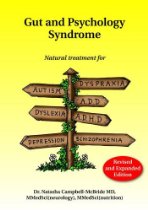developed by: Dr. Natasha Campbell-McBride
 From gapsdiet.com:
From gapsdiet.com:
The Gut and Psychology Syndrome (GAPS) Diet has its foundation on the Specific Carbohydrate Diet (SCD) created by Dr. Sidney Valentine Haas to heal digestive disorders. SCD gained great popularity after a mother, Elaine Gottschall, healed her own child and became an advocate for SCD. Elaine Gottschall is also the author of the popular book Breaking the Vicious Cycle: Intestinal Health Through Diet.
Dr. Natasha Campbell-McBride has taken SCD and evolved it further to create a full protocol for healing digestive disorders and subsequent issues.
Simplified GAPS Outline
Here is a simplified outline of the GAPS Nutritional Program. Please refer to Gut and Psychology Syndrome for more detailed information.
THE NUTRITIONAL PROGRAM
1. Diet
2. Supplementation
3. Detoxification and Life-style Changes
1. Diet
The recommended diet for GAPS patients is largely based on the Specific Carbohydrate Diet (SCD). The main difference pertains to dairy products.
SCD permits lactose-free dairy products. Lactose is a milk sugar. GAPS and people with digestive problems are unable to digest it and must avoid it.
Fermented dairy products such as yogurt are largely lactose free as a result of the fermentation process where by the fermenting bacteria consume lactose. Apart from lactose, milk contains casein which will absorb through the damaged gut lining and act as a toxin in the body.
Another problem with dairy is how it relates to food allergies and intolerances. A milk allergy is one of the most common allergies. Even in breast-fed babies where the mother consumes dairy products the child may develop colic due to sensitivity to dairy antigens being passed through the mother’s milk.
For all of these reasons, GAPS children and adults should not consume dairy products until their digestive system is well enough to handle them. The diet’s only exception to this is milk fat (ghee or clarified butter) because it contains virtually no milk proteins or lactose and is generally well tolerated.
2. Supplementation
The essential supplements for GAPS patients:
A. An effective therapeutic strength probiotic
B. Essential Fatty Acids
C. Vitamin A
D. Digestive enzymes
E. Vitamin and mineral supplements.
3. DETOXIFICATION AND LIFE-STYLE CHANGES
The first and most important thing is to remove the main source of toxicity, which means cleaning up and healing the gut.
Since this alone will not rid the body of years worth of toxic build up in the system, juicing is recommended. Juicing provides very concentrated fruit and vegetable nutrients to the body in an easily absorbed form.
Black Elderberry is also beneficial and has strong immune-stimulating properties and it is one of the most powerful anti-viral remedies known to man.
The General Toxic Load
An important part of the treatment is reduction of the general toxic load. Keep your house chemical free and avoid bringing anything into the home which will let off chemicals such as new carpet, furniture, and paints. Also remember that your skin absorbs just about everything it comes in contact with so be very cautious with the products you put on your skin.
This is a brief summary of important points addressed in Gut and Psychology Syndrome. It is very important to read the sections devoted to these areas in the book for a clear understanding of each.
Helpful Links
GapsDiet.com
The official site for the GAPS diet — based on the book Gut and Psychology Syndrome by Dr. Natasha Campbell-McBride.
GAPS Diet Books
Gut and Psychology Syndrome: Natural Treatment for Autism, Dyspraxia, A.D.D., Dyslexia, A.D.H.D., Depression, Schizophrenia by Natasha Campbell-McBride, Internal Bliss – GAPS Cookbook by GAPSdiet.com, GAPS Guide (Simple Steps to Heal Bowels, Body and Brain) by Baden Lashkov
Articles, Videos and Resources
Additional writings and videos about the GAPS diet.
GAPS Support
Dr. Natasha Campbell-McBride’s website offering support to parents and adults beginning the GAPS diet.
GAPS Practitioners
Listing of physicians, nurses, nutritionists and other health practitioners familiar with the GAPS diet.
GAPS Diet Food List
Chart of recommended foods and foods to avoid.
GAPS Introduction Diet
Most GAPS patients should follow the Introduction Diet before going into the Full GAPS Diet.
The Full GAPS Diet
PDF download outlining the full program for the GAPS Diet.








0 Comments